Meet Report: 2-9 March 2019.
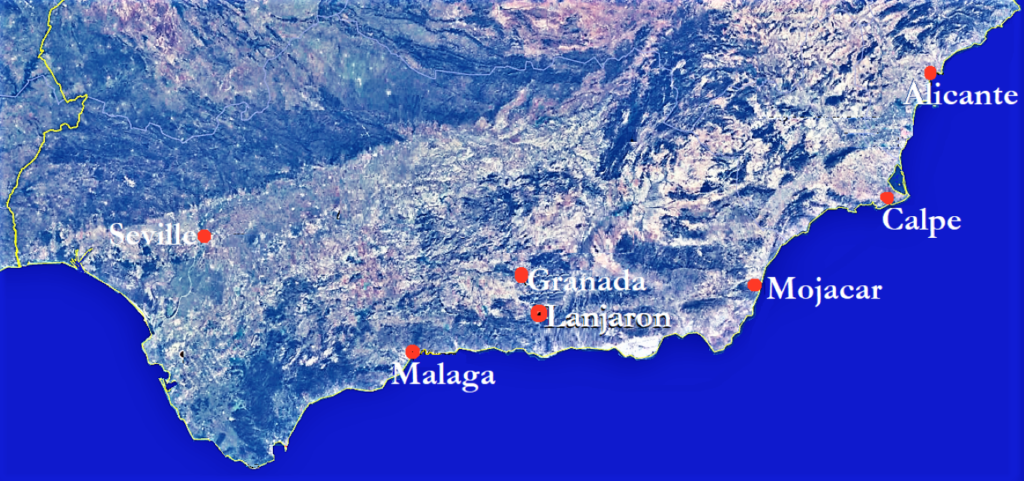
Anyone flying into Malaga airport in Southern Spain in the spring, can scarcely avoid noticing the snow-capped bulk of the Sierra Nevada looming over Granada, topped by Mulhacén, mainland Spain’s highest peak at 3479m. With hill-walking in the Alpujarras (the Sierra Nevada’s southern slopes) and the Cumbre Verde hills to the west, together with winter mountaineering, climbing, skiing and snowshoeing available, it proved to be an attractive venue for a winter/spring meet.
Despite two having to dropout at the last minute, 29 members and guests assembled at the Hotel España in the sleepy spa town of Lanjarón (called the gateway to the Alpujarras) at the start of a very enjoyable week. This 1907-built 2-star hotel was excellent value considering the group rate we secured – clean and comfortable, with central heating that worked (except in the dining room). The staff were warmly friendly and made us feel welcome, especially in the bar.
Saturday 2nd
Mick and Hilary had arrived on the Friday and did a pleasant walk from Busquistar in the Alpujarras, exploring some of the Carrigũelas – medieval Arabic mule tracks. Kjetil and Ann-Karin also arrived the previous day, after a marathon drive from the French side of the Pyrenees. They did the Sendero Forestal – Peñuela, one of the walks above Lanjarón.
Sunday 3rd
Mick and Hilary walked up the Bosca de Pesca (1464m) in the Cumbre Verde hills. Set back from the Sierra Nevada, is a splendid viewpoint oriented towards its north-western slopes which were still holding snow and the nearer limestone peaks surrounding the wild Dilar valley.
Looking for a good but not too demanding first day, a ‘four-hour’ route was selected from suggested routes that came with a map. It took in the Rio Chico and Pico de las Alegas, 2703m. The initial three deciding on this soon ballooned to eleven and the convoy made a hesitant start to Puente Palo picnic area at about 1760m. Forest tracks wound up through the pines before a traverse rightwards awkwardly crossed a wire fence then continued to cross the Rio Chico. The slope above was steep and a feint zig-zagging path was obscured in places by snow banks and pines. These obstacles split the party: some heading straight up to the main broad summit ridge heading north and others with GPS, passing the ruins of Refugio Forestal del Cebollar on the west flank of the peak. All met at the summit where Richard Smith and Kjetil decided on making a circuit of Chico’s headwaters crossing large snowfields to Pico del Tajo de los Machos (The Men’s Craggy Peak), 3085m, then a couple of slightly lower bumps on the way south for a long 1,200m descent off the end of the ridge in failing light. Meanwhile the remainder descended via the ruined refugio using the ascent route. Several Spanish ibex were spotted on the round.

Chris and Ian were unable to locate Vivero Helechores en route – not as it turns out a building, but a plantation marked on our map. Undaunted they took a bold diversion through a previously uncharted forest clearing (known hence forth as the Hawkes – Hilton Gap), crossing the Rio Chico to gain the lower slopes of Picos Alegas. As they approached the summit their hearts were racing. As Richard Smith later informed them, at 2700m, atmospheric oxygen is down from 21% to 14%, so being out of breath was not surprising then! From the rocks along the western edge of the Pico Allegas, they descended via the rather stark Refugio Cebollar and back into pine forests to retrace our outward steps.
John and Ros went for a walk just around the countryside surrounding Lanjarón. Some of the walking was quite steep but with great views. Ros soaked her feet in a lovely fast flowing aquifer to cool off. They finished off with a visit to Lanjarón castle, now ruined and watched the crag martins catching flies in the valley against the cliffs. Many butterflies were seen, the swallow tails were particularly exciting.
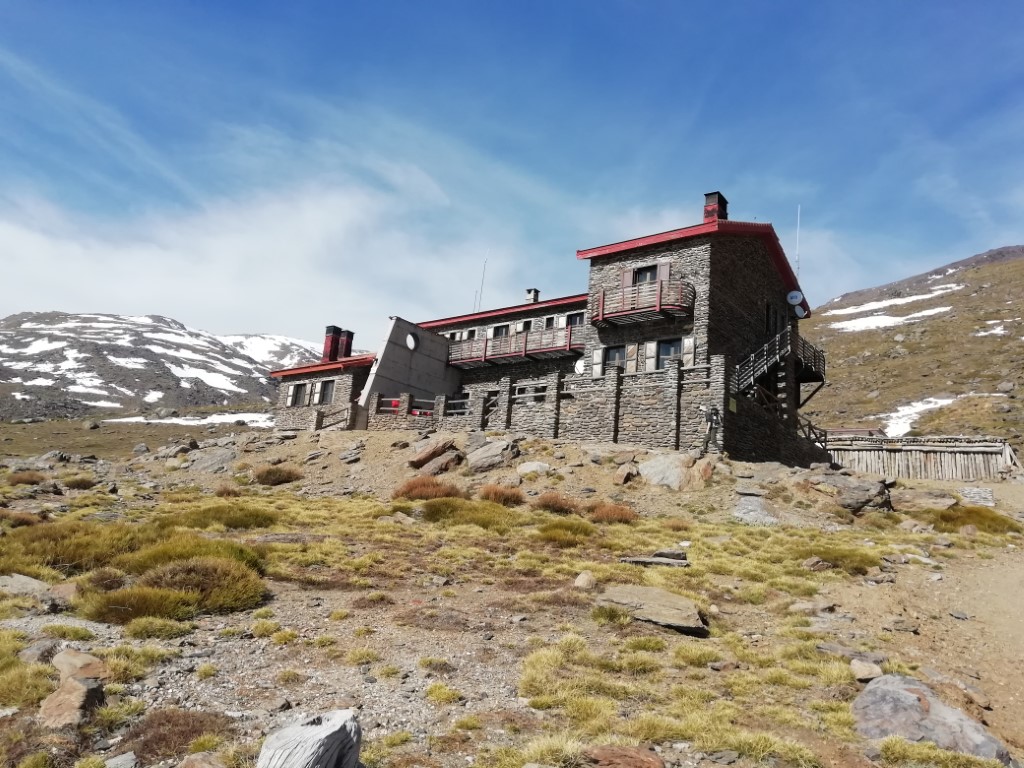
Monday 4th
With a poor mountain weather forecast for our original booking at the Refugio Poqueira, we were fortunate to be able to bring it forward a couple of days for our Mulhacén ascent. The unseasonal warm spell we enjoyed in the UK in February had ablated most of the snow below 2700m on the south side of the Sierra Nevada. As a result, sixteen of us were able to start our walk-in to the hut at the top of a long dirt track at 2600m reached by car from Capileira. Following a picnic at the Hoya de Portillo car park, some 3-4 hours later we were all relaxing on the hut terrace with a beer talking to a group of Brit climbers from the West Country about conditions on the hill.
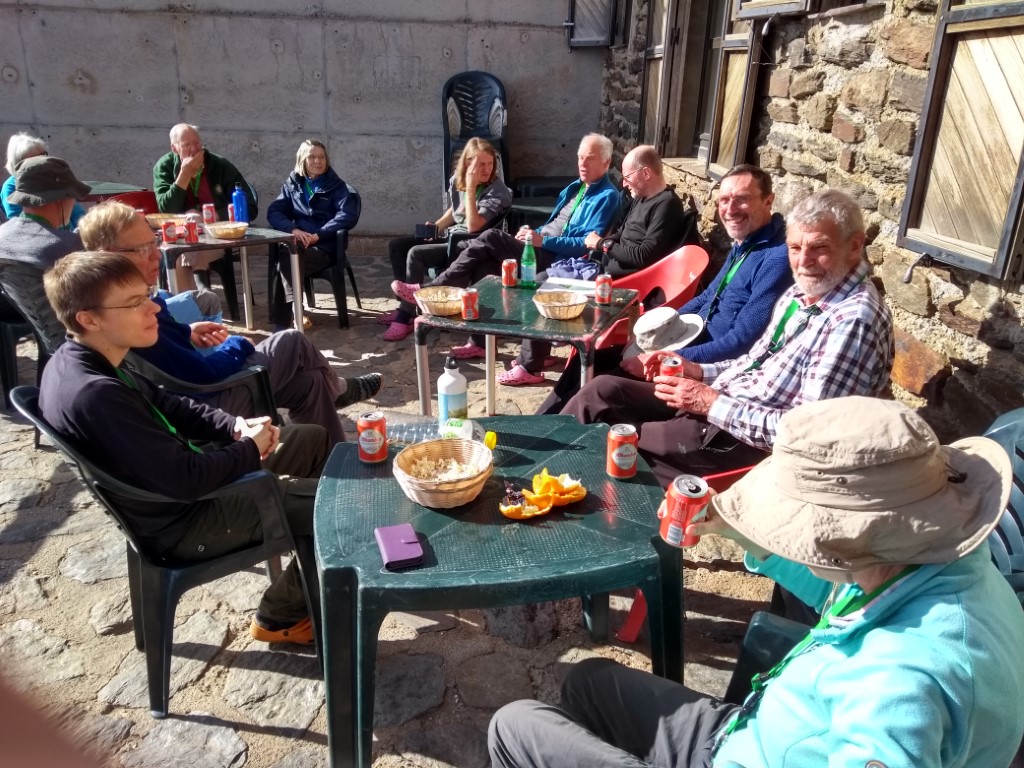
A small herd of cabra montés (Spanish ibex) were photographed near the hut before we come back in for the guardian’s excellent four course dinner. The Refugio Poqueira can be strongly recommended.

Whilst Ros took off for the excitement of Malaga with Hilary and Gail, John took Paul, Alan and Angie up to Hoya del Portillo, were they had lunch with those going higher, then Paul and John walked to the Mirador with lovely views over towards Valeta and Mulhacén ridge. From here they walked over the ridge of Loma de Piedra Blanca (2623m) and also saw some ibex.
Tuesday 5th
After a varied and plentiful breakfast, we set off up the valley beside the infant Mulhacén River, dodging or enjoying long snow tongues as necessary to reach the foot of the west ridge, close to the Refugio Vivac de la Caldera shelter.

Ian became excited (and distracted from the climb ahead), when beside the Rio Mulhacén, Mike discovered garnets in metamorphic rocks, on what were once pre-Alpine sea floor sediments. Crampons were used by some, axes by others and we soon reached the summit trig pillar, which was surprisingly sheltered.
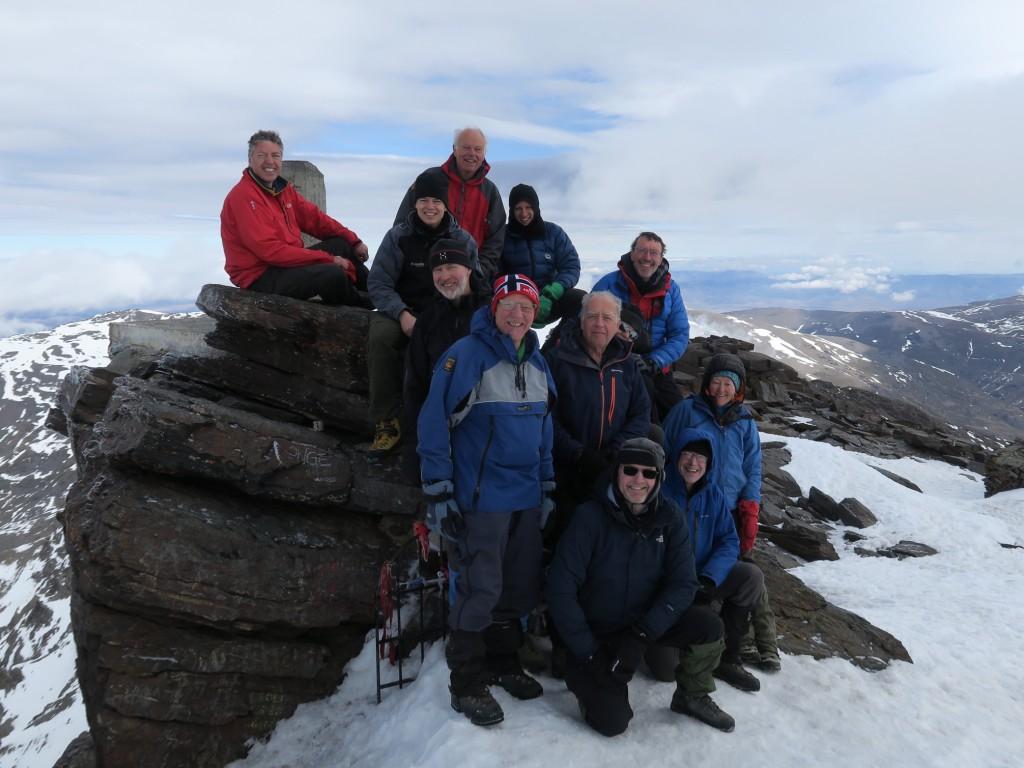
After photos and a quick lunch, we descended Mulhacén’s south ridge in a biting icy wind and gratefully dropped back down to the hut to collect sleeping bags and other kit left behind. Taking a short cut down a snow slope two members descended rather more rapidly than they originally had intended. After suitable refreshments, we descended to the Acequia Alta and followed the sinuous water source back to the cars and just about got back to the hotel in time for a swordfish dinner.
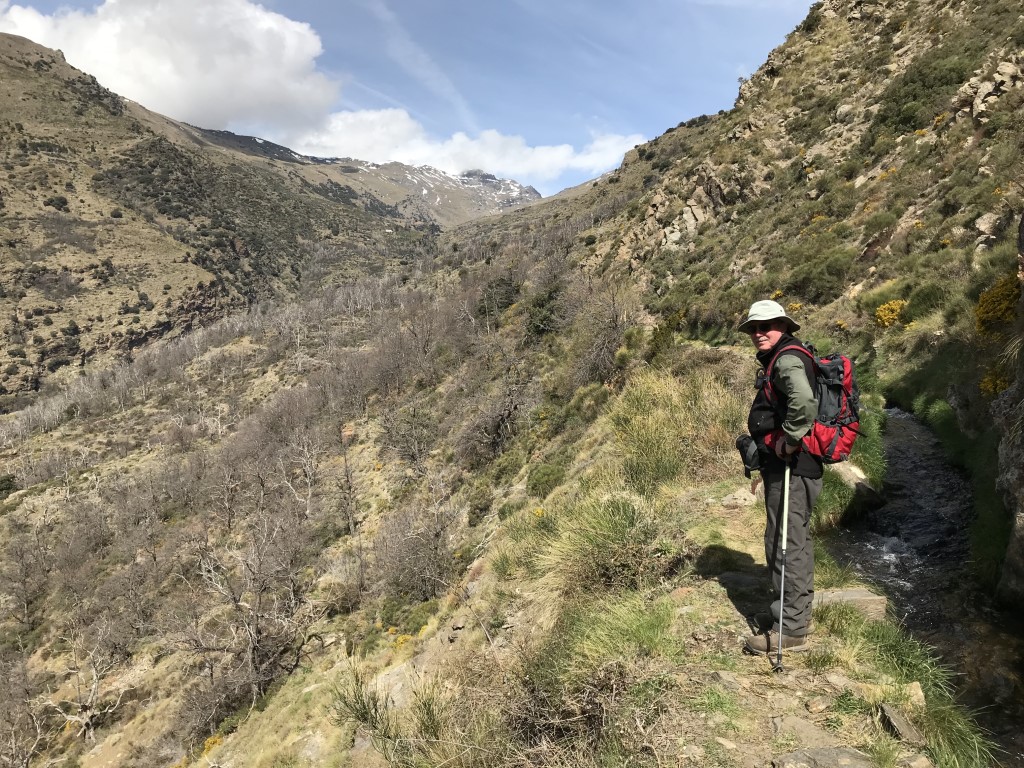
Alan Palmer and John went for a walk to the north of Lanjarón following a rushing aquifer which took then to the Rio de Lanjarón and a small area with some buildings showing the local building technique which was of interest to Alan. Knowing we had to cross the river somewhere, they made their way along the marked PRA-34 route to the river down through 15m cliffs and followed another aquifer to the town. The butterflies were wonderful and to be able to walk through the ancient sweet chestnut forest, with some of the trees at least 400 years old, was a delight.
Wednesday 6th
With cloud and rain in the mountains, Mick, Hilary and Ian opted for a shortish walk around the springs above Lanjarón along the Sendero Acequia Aceituno – Cecarta, followed by a fish lunch at the coast with Nick.
The Chadwicks/Taylors elected to play tourist and visit some of the villages we had raced through en route to Mulhacén. Pampaneira and Bubion were enjoyed in an increasing wind finishing up at Trevelez (at 1476m, the highest village in Continental Spain) where they opted for an out of the way restaurant. After the order had been taken and the lady of the house had confirmed that they really did want to sit outside they were surprised to be approached by whom was believed to be the waiter but turned out to be Chris Hilton! All were disappointed with the village architecture which seemed to comprise of numerous square buildings, until it was realised that that is where all the Alpujarras jamón serrano – cured ham, is hung in the dry wind to mature.
Deciding to have a day sightseeing John and Ros set off for Granada, hopefully to visit the Alhambra It was not until they tried to buy the tickets that they found passports were needed to gain entry! As they did not have them, they drove up to the ski resort at Pradollano. They felt strange to be in the snow watching the skiers. After a good lunch and just as the weather closed in, they made their way back to Lanjarón.
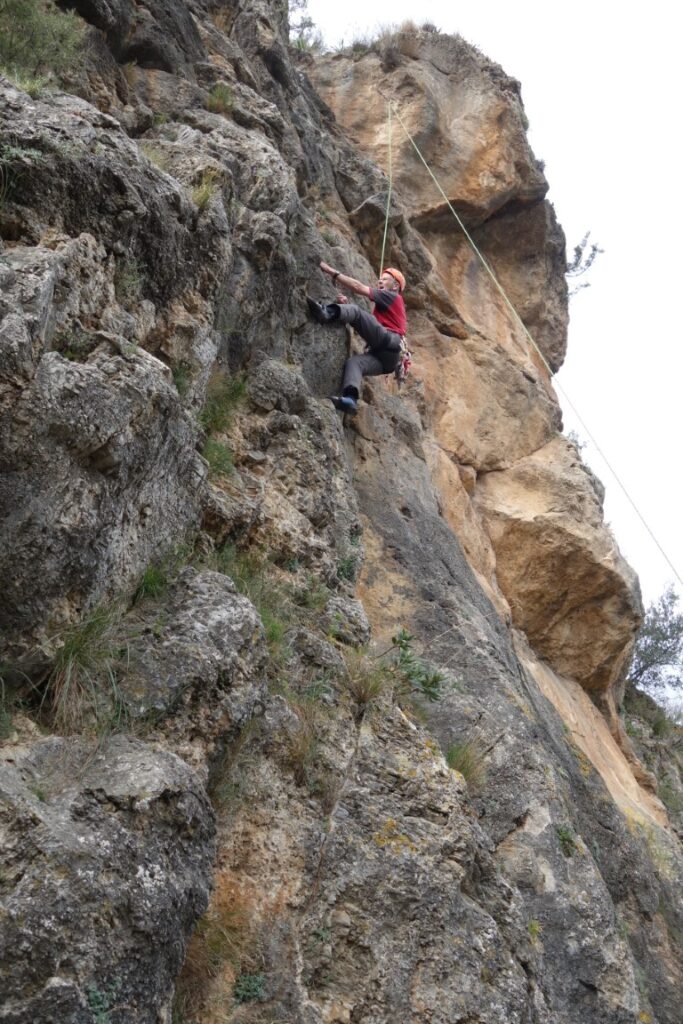
Three made a morning’s visit to Lanjaron crag which is above the western end of Lanjarón. The unattractive approach is through an overgrown dumping ground but the rock itself is good, and the crag adequately bolted. Richard S climbed three 4c sport routes Piolina, Ajos Bastantes and Medios Dias with Tim and Michael repeating or top roping them. The second one was considered much more difficult, so we could have been on El Poeta, 6a. Further to the left, around a corner, Richard climbed a route which might have been Erik el Indino 5a or El Medico Pintura 6a or parts of both.
The PR345 Sendero Circular de Lanjarón’s 6 mile / 9.5km, 650m ascent well-devised route attracted two parties and was explored by others during the week. It took in the Moorish castle, cobbled mule trails, hermita, crags, river, aqueducts, ornamental gardens and olive groves. Richard and Michael spotted a fox while they sheltered under an overhang waiting for a shower to pass.
Thursday 7th
The sunny weather fortuitously returned, and a large party headed over to the Cumbre Verde hills to climb the shapely Cerro del Trevenque (2079m) by its western ridge, topped with some mild scrambling.






On the subsequent descent through the forest, several nose-to-tail chains of fully-grown pine processionary moth caterpillars were observed on the move, the largest having some 59 members extending to about 1.25m in length following each other’s pheromone trail to find suitable pupation sites in the ground.

This attractive area was visited again the following day by three who had missed out the day before.
John and Ros drove to La Zubia and walked up into the Cumbres Verdes, through the warm pine woods along a dry valley which gave commanding views over Granada and was a very pleasant days walk.
Meanwhile a party of five young and young at heart (three Richards, Billy and Ethan) decided that the Sierra Nevada ski slopes required a review. Despite a 0700 reveille, all were up on time and at the slopes before the lifts opened. Once they had found the quieter back and less icy slopes, a very enjoyable day was spent with much less expenditure of energy than is likely to be the case on the forthcoming Norway cross country skiing expedition.
Friday 8th
Chris drove Mick, Ian and Alan Palmer for an hour up a dirt track to the roadhead beneath the old Refugio Ventura and set off to climb the Cerro de Caballo (3005m), Europe’s most southerly 3000m peak, an outing of some 22.5km, 1280m ascent. Following our experiences earlier in the week, we didn’t bother with axes and crampons and picked our way across the Loma de Lanjarón trying to follow a thin path that kept disappearing under snowfields of variable delicacy. Under increasing cloud which largely deprived us of good views, we arrived at the summit pillar by two separate routes.



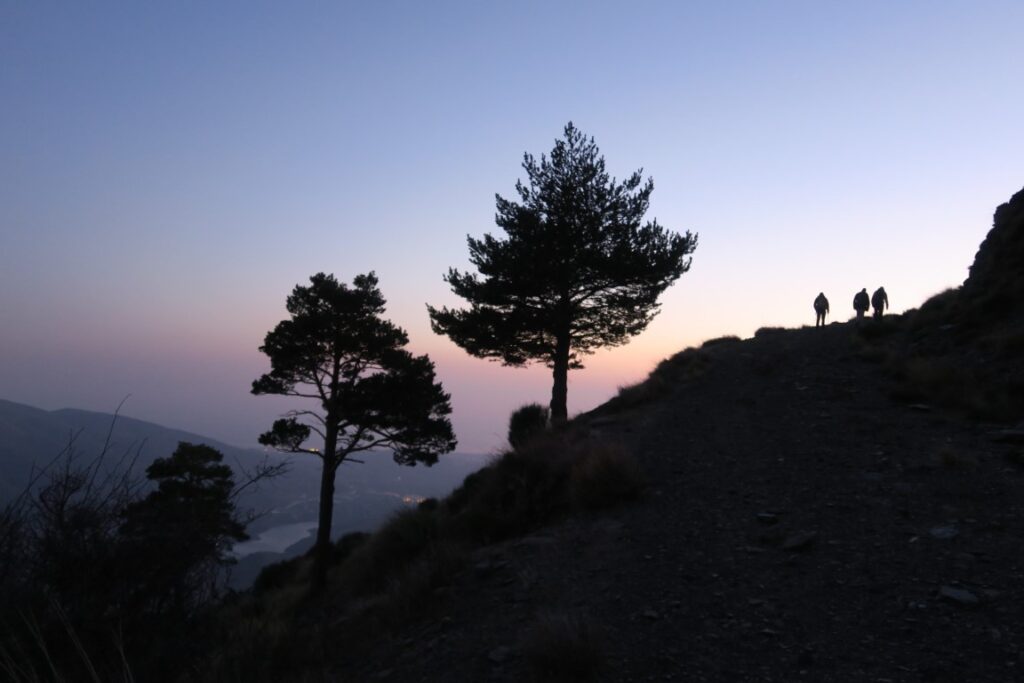
A rapid descent was made together to get out of the wind to stop for some food. We descended rapidly and eventually reached the main Ventura path helped by GPS and enjoyed one of Chris’s rallying descents in the car to scrape in just before the dinner gong.
On the opposite side of the A-44 motorway from Lanjarón lies the Embalse de Baznar in the Lecrín valley with the traditional villages of Restábal and Melegis on the hillside above. Rounds of these three provided outings for several members. Wildlife sightings and bar/café visits provided additional amusement when following the waymarked trails which were typically several kilometres long with a few hundred metres of ascent.
The Taylors/Chadwicks felt more culture was in order and celebrated their victory over the on-line Alhambra booking system with an interesting but mentally exhausting visit to the Generalife Gardens and the Palace. They finished off the day in true YRC style by taking afternoon tea and cakes on the terrace of the 5-star Alhambra Palace Hotel. Richard wisely volunteered to retrieve the car whilst Peter settled the bill.
For their final full day John and Ros spent time walking and driving around the Embalse de Beznar reservoir. As they looked over the dam, they saw at least 50 brown trout turning lazily in the water. They stopped to take in some of the villages en route. In Restabal they walked down through the narrow streets to the water’s edge. At Talara, they sampled coffee and the best cakes ever seen, all home-made. Whilst walking at Beznar, the next village, they were able to sit and watch a stoat hunting. There were also orchids growing here, a very pleasant place.
Saturday 9th
Most people travelled back to Malaga for their various flights home, some stopping for lunch on the beach at Nerja. Mick and Hilary drove over to the Sierra de Grazalema of the far side of Ronda for another week exploring the sunny limestone countryside and raptor spotting.
Note from Alan Linford
The area offered ample local walks and access to three National Parks ideal for those in the Club with lower horizons but still enjoy being on meets. Coolidge in early YRC letters would deny the title ‘mountaineer to rock scramblers’ – what title for those members who simply enjoy all that a club meet has to offer? Tourists maybe…
On Day 1 we had an early flight and took a taxi from the airport to Lanjarón, organised by Spanish Highs who were most helpful, giving us all afternoon to find the best bars and more importantly the starts to all the walks, helped by some pdf downloads.
Nearby were the Parque del Salado and the Paseo de Castillo which led to Lanjarón Castle, an after-lunch walk for some but a mountain for Dave Martindale. The National Parks provide well-maintained paths and we were just in time to see the orange trees in fruit and blossom.
Participants
Mick Borroff (leader), John Brown, Ros Brown (G), Ann Chadwick (G), Peter Chadwick, Ethan Dover (G), Paul Dover, Richard Dover, Ian Hawkes, David Hick, Chris Hilton, Tim Josephy, Angie Linford (G), Alan Linford, Christine Marriott (G), Dave Martindale, Alan Palmer (PM), Tony Penny, Val Penny, Billy Sarakan (G), Helen Smith, Michael Smith, Richard Smith, Gail Taylor (G), Richard Taylor, Hilary Tearle (G), Ann-Karin Tveranger (G), Kjetil Tveranger and Nick Welch.
Val’s Birds List
| Greenfinch | Chaffinch | Goldfinch | Great Tit | Long-Tailed Tit | Blue Tit | Coal Tit | Stonechat |
| Alpine Accentor | Golden Eagle | Swift | Red Billed Chough | Cormorant | Green Woodpecker | Spotted Woodpecker | Blackcap |
| Black Redstart | Jackdaw | Raven | Robin | Shoveller | Great Crested Grebe | Little Grebe | Mallard |
| Coot | Moorhen | Marsh Harrier | Chiffchaff | Spanish Sparrow | Thekla Lark | Wren | Kestrel |
| Black Wheatear |
Val’s Butterflies List
| Common Blue | Silver-Studded Blue? | Long-Tailed Blue | Small Copper | Green Hairstreak | Swallowtail | Scarce Swallowtail | Spanish Festoon |
| Red Admiral | Peacock | Painted Lady | Large White | Small White | Bath White? | Speckled Wood | Moroccan Orange Tip |
| Large Tortoiseshell | Small Tortoiseshell | Spotted Fritillary | Cleopatra | Brimstone |
Leave a Reply